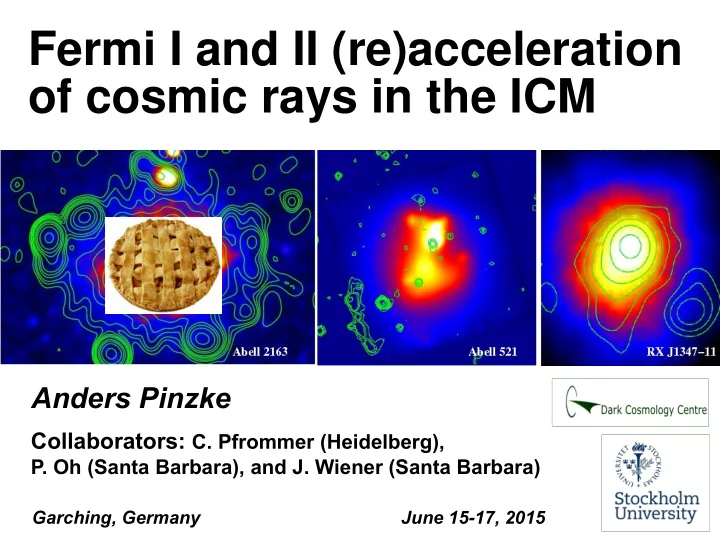

Fermi I and II (re)acceleration of cosmic rays in the ICM Anders Pinzke Collaborators: C. Pfrommer (Heidelberg), P. Oh (Santa Barbara), and J. Wiener (Santa Barbara) Garching, Germany June 15-17, 2015
Signs of non-thermal activity in galaxy clusters radio radio relics halo A 2163 A 3667 Radio: Feretti at al, 2004 Radio: Johnston-Hollitt.; X-ray: ROSAT/PSPC.
A radio relic poster child: A2256 α ν = 0.85 → Mach = 2.6 How is this possible???
Biggest unknown: Shock acceleration efficiency Bruggen+ 2012 radio relics Outskirts dominated by low Mach number shocks. These shocks have low acceleration efficiency.
Diffusive shock acceleration – reacceleration through Fermi I CRe cooling times f(p) Plasma processes: super thermal tail - accelerated Relativistic particle pop.: Maxwellian m e aged CR population - all particles reaccelerated strong shock weak shock p Fermi I reacceleration: e.g. Kang and Ryu, 2011, Kang+ 2012, Pinzke+ 2013, Bonafede+ 2014, Vazza+ 2014
Fossil CR electron population Pinzke+ 2013
Fermi-I re-acceleration in radio relics relative CRe contributions x u l f o i d a r Mach number Mach number Pinzke+ 2013 Fossil contribution comparable to direct injection at high M Dominates at low M !
Giant radio halo – Fermi II reacc. Relativistic populations and radiative processes in clusters: kinetic energy from supernovae & Energy sources: structure formation active galactic nuclei turbulent cascade Plasma shock waves & plasma waves processes: - Fermi I - Fermi II re-accelerated CRs CR electrons & protons Relativistic - Fermi II - Fermi I particle pop.: Observational diagnostics: radio synchrotron gamma-ray hard X-ray emission emission Hadronic: e.g. Ensslin+ 2011, Wiener+ 2013, Zandanel+ 2013, Zandanel and Ando 2014, Pfrommer+ 2004,2008, Pinzke and Pfrommer 2010, Pinzke+ 2012 Fermi II reacceleration: e.g. Brunetti+ 2001,2004,2012, Brunetti and Lazarian 2007, 2011, Petrosian 2001, Cassano and Brunetti 2005
Fermi II reacc. - CRs Acceleration mechanism: Compressible MHD turbulence L inj = 300 kpc, (V turb /C s ) 2 =0.22, τ reacc = 650 Myr, isotropic Kraichnan turbulence radio interval time Brunetti and Lazarian 2007, 2011, Brunetti+ 2012
Fermi II reacc. - uncertainties flat CR profile (out to ~0.4 R 200 ) - strong tension with simulations possible solutions: y t i CRp streaming s n e d ϵ turb /d R << d ϵ th /d R d y g primary CRes r e n alpha_B << 0.5 E Radius Pinzke+ 2015
Fermi II reacc. - uncertainties flat CR profile (out to ~0.4 R 200 ) - strong tension with simulations possible solutions: y t i CRp streaming s n e d ϵ turb /d R << d ϵ th /d R d y g primary CRes r e n alpha_B << 0.5 E Radius Pinzke+ 2015 Realistic cluster simulations with relevant physics need to fully establish Fermi II reacceleration models!
Streaming and diffusion – CR protons Ensslin+ 2011, Zandanel+ 2013, 2014, Wiener+ 2013 Small anisotropy in CRs (frame of waves) ⇒ momentum transfer CRs → waves ⇒ wave growth rate Kulsrud and Pearce 1969 ⇒ grows until scattering renders CRs isotropic , v D ~ v A ⇒ self-confjnement Turbulence damps growth of waves since waves cascade to smaller scales before scattering CRs Farmer and Goldreich 2004 Wiener+ in prep. Adopt steady state, Γ grow = Γ damp CR protons in clusters stream outward faster than inward turbulent advection Wiener+ 2013
Fermi II reacc. - three scenarios 1) Flat turbulent profile (M- turbulence, α tu = 0.66 ) – secondary CRes and CRps, reaccelerated by flat turbulent profile – α tu < 1 motivated by cosmological simulations, Lau et al. 2009; Shaw et al. 2010; Battaglia et al. 2012 2) Streaming CRps (M- streaming, α tu = 0.81 ) – secondary CRes and streamed CRps, reaccelerated – CRp streaming needed in hadronic model, unexplored for ICM, Ensslin+ 2011, Zandanel+ 2013, 2014, Wiener+ 2013, Pinzke+15 3) Primary CRes (M- primary, α tu = 0.88) Turbulent energy ratio – primary CRes with K ep = 0.1, reaccelerated – high K ep motivated by radio relics and lack of γ -ray emission, e.g. Vazza & Brüggen 2014 Radius Pinzke+ in prep.
Fermi II reacc. – radio spectrum COMA Pinzke+ 2015 All three proposed scenarios reproduce observed radio spectrum Pure hadronic model (DSA only) can not reproduce spectrum
Fermi II reacc. – radio profiles COMA Pinzke+ 2015
Fermi II reacc. – gamma-rays COMA Pinzke+ in prep. Fermi-LAT can probe M-streaming and M-turbulence in near future!
Take home messages Radio relics Fermi I reaccelerated fossil CR electrons in cluster outskirts can explain radio emission from low Mach number shocks Giant radio halos Classical hadronic models ruled out by radio observations Fermi II reacceleration preferred, however, tension between initial CR distribution and simulations 3 different solutions to the problem – primary CRes (large K ep ) – streaming CRps that produce secondary CRes – CRps and secondary CRes reaccelerated by flat turbulent profile Fermi I & II reacc. can reproduce both radio and gamma-ray observations in halos and relics!
Thank You
Recommend
More recommend